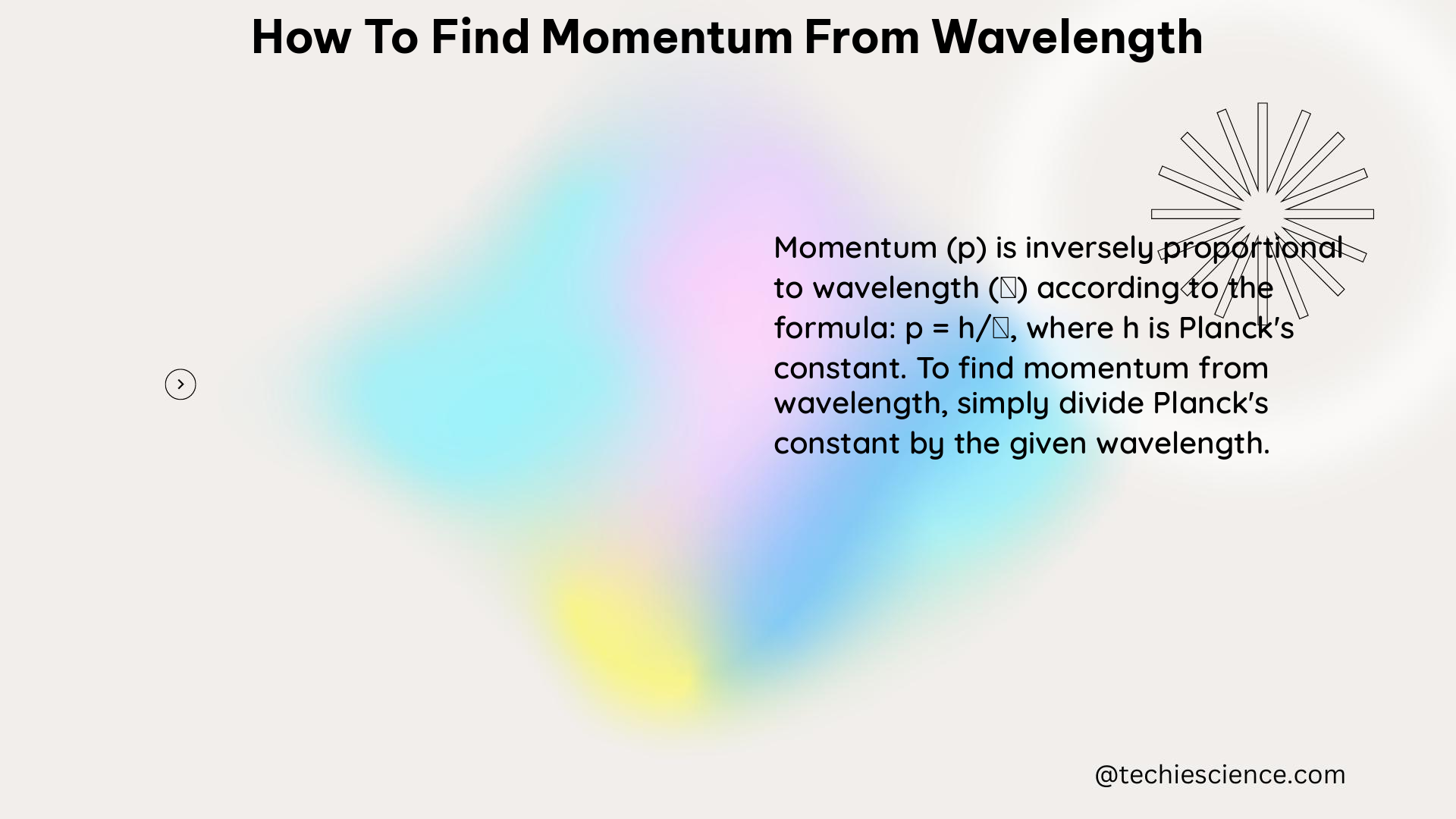In the realm of quantum physics, the relationship between the momentum of a photon and its wavelength is a fundamental concept that every physics student must grasp. This comprehensive guide will delve into the intricacies of this topic, providing you with a deep understanding of the underlying principles and equipping you with the necessary tools to calculate the momentum of a photon from its wavelength.
Understanding the Momentum-Wavelength Relationship
The momentum of a photon is directly related to its wavelength, as described by the formula:
p = h / λ
where:
– p is the momentum of the photon in kilogram-meters per second (kg·m/s)
– h is the Planck constant, which has a value of approximately 6.63 × 10^-34 J·s
– λ is the wavelength of the photon in meters (m)
This formula is derived from the wave-particle duality of light, which states that light exhibits both wave-like and particle-like properties. The momentum of a photon is a manifestation of its particle-like nature.
Calculating Photon Momentum from Wavelength

Let’s consider a practical example to illustrate the application of the momentum-wavelength formula.
Suppose we have a photon with a wavelength of 500 nanometers (nm), which is in the visible light spectrum. To calculate the momentum of this photon, we can substitute the values into the formula:
p = h / λ
p = (6.63 × 10^-34 J·s) / (5 × 10^-7 m)
p = 1.33 × 10^-27 kg·m/s
This means that the momentum of the photon with a wavelength of 500 nm is approximately 1.33 × 10^-27 kg·m/s.
Calculating Total Momentum for Multiple Photons
In a scenario where we have multiple identical photons, we can calculate the total momentum by multiplying the momentum of a single photon by the number of photons. The formula for this calculation is:
p_total = N × p
where:
– p_total is the total momentum of the photons
– N is the number of photons
– p is the momentum of a single photon
For example, if we have 10 identical photons, each with a momentum of 1.33 × 10^-27 kg·m/s, the total momentum would be:
p_total = 10 × (1.33 × 10^-27 kg·m/s)
p_total = 1.33 × 10^-26 kg·m/s
Relationship between Momentum, Frequency, and Energy
The momentum of a photon is not only related to its wavelength but also to its frequency and energy. These relationships are described by the following equations:
- Wavelength-Frequency Relationship:
c = λ × f
where: cis the speed of light, approximately3 × 10^8 m/sλis the wavelength of the photon in meters (m)-
fis the frequency of the photon in hertz (Hz) -
Momentum-Energy Relationship:
E = p × c
where: Eis the energy of the photon in joules (J)pis the momentum of the photon in kilogram-meters per second (kg·m/s)cis the speed of light, approximately3 × 10^8 m/s
These relationships are crucial for understanding the behavior of light and other electromagnetic waves, as they allow us to connect the various properties of photons and predict their interactions with matter.
Practical Applications and Numerical Examples
The ability to calculate the momentum of a photon from its wavelength has numerous practical applications in various fields of physics, such as:
-
Spectroscopy: Determining the momentum of photons emitted or absorbed by atoms and molecules can provide valuable information about their electronic structure and energy levels.
-
Particle Physics: In high-energy particle collisions, the momentum of photons and other particles is a crucial parameter for understanding the underlying processes and conservation laws.
-
Astrophysics: Analyzing the momentum of photons from astronomical sources, such as stars, galaxies, and quasars, can reveal information about their physical properties and the processes occurring in the universe.
Let’s consider a few numerical examples to solidify your understanding:
Example 1:
– Wavelength of a photon: 650 nm
– Calculate the momentum of the photon.
p = h / λ
p = (6.63 × 10^-34 J·s) / (650 × 10^-9 m)
p = 1.02 × 10^-27 kg·m/s
Example 2:
– Momentum of a photon: 2.5 × 10^-27 kg·m/s
– Calculate the energy of the photon.
E = p × c
E = (2.5 × 10^-27 kg·m/s) × (3 × 10^8 m/s)
E = 7.5 × 10^-19 J
Example 3:
– Wavelength of a photon: 450 nm
– Calculate the frequency of the photon.
c = λ × f
f = c / λ
f = (3 × 10^8 m/s) / (450 × 10^-9 m)
f = 6.67 × 10^14 Hz
These examples demonstrate the practical application of the momentum-wavelength relationship and the interconnectedness of various photon properties.
Conclusion
In this comprehensive guide, we have explored the fundamental concept of finding the momentum of a photon from its wavelength. By understanding the underlying formula, p = h / λ, and the related equations, you now have the necessary tools to calculate the momentum of a photon, the total momentum of multiple photons, and the connections between momentum, frequency, and energy.
Remember, mastering this topic is crucial for your success in physics, as it underpins many important phenomena and applications in various fields. Keep practicing with the provided examples and continue exploring the fascinating world of quantum physics.
Reference:
- https://www.nagwa.com/en/explainers/725104643703/
- https://www.vaia.com/en-us/textbooks/physics/physics-1-edition/chapter-15/problem-2-is-there-any-measurable-difference-between-the-mom/
- https://courses.lumenlearning.com/suny-physics/chapter/28-6-relativistic-energy/

The lambdageeks.com Core SME Team is a group of experienced subject matter experts from diverse scientific and technical fields including Physics, Chemistry, Technology,Electronics & Electrical Engineering, Automotive, Mechanical Engineering. Our team collaborates to create high-quality, well-researched articles on a wide range of science and technology topics for the lambdageeks.com website.
All Our Senior SME are having more than 7 Years of experience in the respective fields . They are either Working Industry Professionals or assocaited With different Universities. Refer Our Authors Page to get to know About our Core SMEs.